Walking your Staffy can be one of life’s simple pleasures. In fact it is one of my favorite activities to do with my Staffordshire Bull Terrier. Walking is great exercise, and an excellent way to bond with your dog. Walking your Staffy is also a great way to relieve stress, but for some it can be a frustrating chore.
How do I stop my Staffy from pulling on leash? There are several approaches to teaching your Staffy to walk on a loose leash. Techniques involving redirection, structured routes, changing directions and varying pace can all help. Patience, practice and consistency will be needed in this training.
When my Staffy was just a puppy learning leash manners was a top priority for me. I had been a dog walker for a number of years before I got her so I knew how important this training was going to be. The techniques I learned as a dog walker were vital in teaching my Staffy not to pull on leash.
In this post I will cover the various techniques I used to train my Staffy not to pull on leash. Even if you have an older Staffy that has terrible leash manners these techniques can work for you with enough time, patience, and consistent practice. Let’s dig in.
How Do You Leash Train A Staffy?
Leash training a Staffy should start from a very early age. You will want to get your dog accustomed to the idea of wearing a collar or harness around the home first before heading outside. Once you are ready for a walk outside make sure to bring plenty of treats and patience.
Teaching your Staffy how to walk on leash without pulling is going to take time. For some your dog might naturally walk very well, for others it is going to take time and consistent practice. Remain calm, and always use positive reinforcement when training your Staffy.
How Do You Train A Staffy Not To Pull?
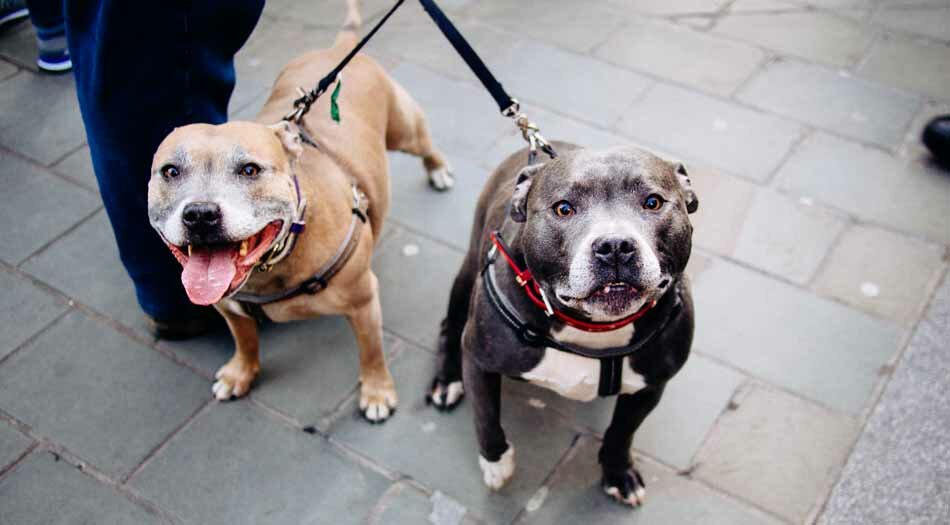
Training a Staffy not to pull on lead requires a few different techniques that should be applied calmly, consistently, and in a positive manner. Leash training should start indoors before heading out outside. When on your walks you need to set the tone, plan your walks, apply different redirection techniques, and learn your dog’s body language and triggers.
These are the techniques I used when I trained my Staffy to not pull on leash. Applied correctly, patiently, and across a consistent period of time you can have your Staffy walking on a loose leash too.
Start Indoors
Start your Staffy’s leash training indoors first. Allow your dog to get used to the idea of wearing a collar or harness before you head out into the world. By doing this you can practice walking around your living room in an environment where you have your Staffy’s full attention.
Practice a walk with your Staffy’s favorite treat in hand from one side of the room to the other. Encourage your dog to be focused on you and walking on the leash loosely. Do this a few times over the course of about 15 minutes and reward your dog in a calm, encouraging, and positive manner when they complete the exercise.
Set The Tone

Setting the tone for the walk is probably one of the most important things you can do. This technique will set you and your Staffy up for success right from the beginning. Having the right state of calm and focus with your dog before heading out the door will get you both off on the right foot. Pun intended.
Step 1: Gearing Up For The Walk
It all starts with leashing your Staffy up. Placing their collar or harness on should be done in a very calm and controlled manner. If your dog is moving around, jumping, whining, or in a state of general excitement you need to wait for them to calm down before you put their walking gear on.
It is important not to get your Staffy excited before the walk begins. All too often I see people hype their dogs up to “go for a walkie!!!” and then wonder why their dog is crazy on leash. Start the routine in a calm manner. When your Staffy is in a calm sit or stand position, then you can get ready to go outside.
Resources & Reviews – The Best Leashes, Harnesses, & Collars for Bully Breed Dogs
Step 2: Leaving The House
Leaving the house is the second key step in setting the tone for your walk. Don’t allow your Staffy to burst out the door. Your dog needs to calmly step out into the outside world and keep their focus with you.
The way I maintain this with my Staffy is through the routine of having her wait calmly as I open the door. She doesn’t cross the threshold until I give her the “okay” release. Once released from her “sit” she calmly steps through the door and sits again at attention. This allows me to close and lock the door while she waits patiently.
From this point I only begin the walk when I have her full attention and she is in a calm state. She can be happy, or even slightly eager to be going for her walk, but she must be focused on me to lead the way. This is how you set the tone for walking your dog on a loose leash.
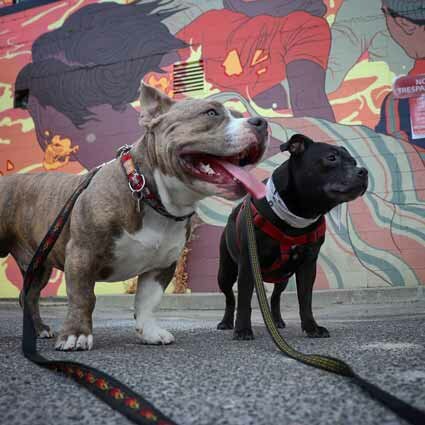
Join the adventures of Ruby The Staffy & Chester The Pocket American Bully!
Subscribe to our YouTube Channel!
Have A Plan For Walks
When you are teaching your Staffy how to walk on leash it’s important you have a game plan. Training your Staffy not to pull will mean you have a route planned and the structure of your walk front of mind. This was exactly how I trained my Staffy to walk on a loose leash.
So what do I mean by having a route planned and having structure in place? Simply know where you are going to be walking before leaving the house. If your Staffy gets particularly distracted by a certain area, neighborhood dog, or kids playground, find an alternate route. At least in the beginning of training.
Eliminating unnecessary distractions in the beginning of leash training your Staffy will make it easier for them to focus on you and the task at hand. Building up to walks with distractions is something that comes further along in the process. Get the basics down first and plan your route.
Structure Your Walk
Structure for your walks is crucial for training a Staffy not to pull on leash. This means that the walk is a focused activity of focused walking. Allow your Staffy a quick potty break at the beginning of the walk, regain their full attention, and begin your walk at a steady pace.
The walk should be focused 100% on the act of walking. No sniffing around, no stopping to mark, no interactions with other people or dogs. Walking. The goal is to get your Staffy into a steady rhythm and build yourself as the leader of the activity. No distractions for you either. No cell phone calls, no chit chat with neighbors, just steady paced walking.
You might think this seems too rigid for a nice walk, but for training your Staffy not to pull it’s important. Staffy’s also enjoy structure and having calm leadership, so this type of walk is enjoyable for your dog.
Plant Your Feet – Reward Loose Leash Walking
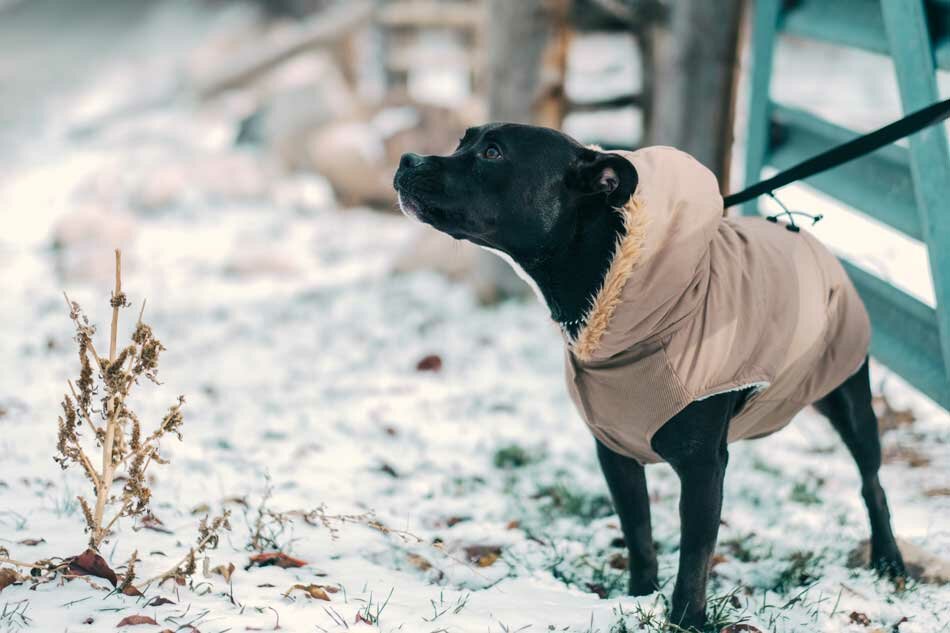
We’ve made it this far. You have set the tone of the planned walk and you are keeping things structured. Yet your Staffy is still pulling on leash. This is where the training of pressure and release comes into play.
One of the earliest things my Staffy learned during her leash training was that pulling was going to get her nowhere. Whenever she began to pull I would plant my feet and not let her move forward on the leash. Even when we would stop for a pee and she would pull to sniff something, my feet would firmly plant.
This teaches your Staffy that applying pressure in the direction opposite of you is a wasted effort. I would keep my feet planted and not move for as long as it took for my Staffy to release the tension on the leash, once that occurred we continued forward. The second tension in the leash happened again. We stopped.
After only a couple weeks of consistent walks did my Staffy finally realize how this system worked. The moment she pulled forward and felt tension she would immediately back off to a loose leash again. It was amazing to watch her figure this out, and helped dramatically with her leash manners.
This can take a bit of time to learn, so remain patient and consistent in your application of the technique. Recall your Staffy to your side with a treat if you must to get back to a loose leash, but never let them pull you in any direction. Plant those feet and stand your ground until the tension is released.
Switch Directions
One of the primary goals of training your Staffy to not pull on leash is to have them follow you. Leash pulling occurs when your dog is out in front of you most of the time. Occasionally they will be pulling off to the side, but will still be slightly in front of you. A change in directions is a way to position yourself out in front again.
An alternative method to the stopping and planting your feet method is the switch directions technique. When your Staffy begins pulling up front or to the side, simply change the direction you are walking so they are now behind you.
This switch in directions should be abrupt, but not forceful to the point of potentially hurting your dog. Enough of a change in their forward momentum to throw them off course and reorient them back to following you.
Once your Staffy has followed your change in direction and is walking on a loose leash you can calmly give them some verbal praise. “Good girl, walk nice” was my cue that I was happy with my Staffy following me.
Again this can have you turning in circles for most of your walk in the early days. That’s okay, this is all a part of the training. Remain calm and consistent as you and your Staffy practice this method.
Focus On The Time, Not The Distance
Leash training is not about covering a certain distance, it’s about putting in the necessary time to learn. As a dog walker I often heard people complain that doing the switch direction or feet planting method had them barely getting around the block with their dog.
To that I say, yeah so? Learning to walk on a loose leash with your Staffy is not about getting a covering of a lot of ground, it’s about training them to not pull. Focus on the time you’re teaching them not pull.
There were days where I barely made it around the block as well, and that was perfectly fine with me. By the end of the walk my Staffy was that much better at loose leash walking. In the end the short distances covered resulted in a lifetime of amazing loose leash walks for as far as we could manage. Baby steps in the beginning will pay off down the road.
Walk In Circles And Figure 8s
There were some days where changing directions and planting my feet just didn’t seem to be clicking with my Staffy. Instead of getting frustrated I just moved to another useful technique that would allow my dog to follow my lead much easier.
Walking in circles or a figure 8 pattern will force your Staffy to follow your lead much more than travelling in a straight line. I used this technique quite often in the early days of leash training. First by starting off walking in fairly tight circles. Around about 5 feet diameter, then gradually increasing the size of the circle.
This walking in a circle had my Staffy constantly focusing on me and my direction. This allowed for several rotations of loose leash walking. Once I had expanded the size of my walking circle I would introduce a bit more of a challenge by walking in figure 8 patterns or change from a clockwise to a counter-clockwise direction.
Use this technique as an opportunity to have your Staffy focus on you and walk loose on a leash. Practicing this method might feel like you are going in circles, but trust me it works to establish walking habits. Always praise and reward your dog for their good work to reinforce their leash manners.
Vary Your Pace
Varying your pace during a walk is a good way to challenge your Staffy. Once they are starting to get the hang of loose leash walking, change up your walking speed. This change in pace will interrupt any distraction or pulling that may be starting and get them to adjust to your speed.
This technique is used to further solidify the goal of your Staffy following you, the leader. I used this with my Staffy all the time after a few months of practice. Slowing down from a medium pace so she backs off and walks beside me slower, then speeding up so she has to maintain a faster speed.
Practice varying your pace on your walks once your Staffy has started to understand the concept of loose leash walking. This added challenge will build on their ability and need to focus on you more, and learn to walk at your pace, not theirs.
Understand Your Dog’s Body Language
Establishing a bond with your dog is important in understanding their body language. Training your Staffy to not pull on leash also includes understanding how they are feeling at the moment. Leash pulling can occur when your dog is under stress, anxious, or uncertain of certain things in the environment.
When your Staffy is showing signs of over excitement, anxiety, or general uncertainty, leash training becomes difficult. There is a difference between a distracted dog and a dog that is unable to focus. This difference shows up in their body language.
Learn to understand your Staffy’s body language and remove them from situations that are creating their inability to focus. Training under a stressful or over exciting situation is near impossible. Set your dog up for success and understand what they are communicating.
Challenge Your Staffy
When you finally reach a level of loose leash walking where you Staffy is doing really well, it’s time to level up. Under ideal circumstances you can teach any Staffy to not pull on leash, once they have achieved this they will need a bit more of a challenge.
Bring your Staffy to more stimulating areas for their walks. Remember in the beginning where I mentioned planning a route that was free from loud noises, other dogs, kids playgrounds? Now is the time to give these environments distractions a test.
Start off slow with one distraction at a time. Maybe a change in your route to briefly pass that neighbor dog that likes to bark. Keep all the same methods in place by walking in a structured manner, using a feet planting or direction change when necessary, and work towards a loose leash walk past the distraction.
You may not succeed the first time, or maybe even the tenth time, but keep practicing. Always end your walks with a good amount of loose leash walking so you don’t regress backwards with these new challenges. Try to incorporate them somewhere in the middle of your outing where possible.
I did this with my Staffy when I lived in the downtown area of a large city. Typically we stuck to some of the quieter areas, but as we got better we ventured further out. After a few weeks my Staffy was able to walk calmly beside me in busy downtown foot traffic. Dogs, people, sounds, and smells everywhere, and she followed me around faithfully on a loose leash.
Related Article – Are Staffies Easy To Train? – 10 Simple Training Tips
Be Consistent
None of the above mentioned tips, tricks and techniques will work without consistency. All dog training requires consistent practice and application for them to work effectively. Staffies require a good amount of exercise, so training not to pull on leash should be a twice a day practice for you and your Staffy.
Be consistent in your application. Don’t allow your Staffy to pull on leash one day, but plant your feet and change direction the next day. Always apply the techniques the same way across time. This will be the key to your success.
Final Thoughts
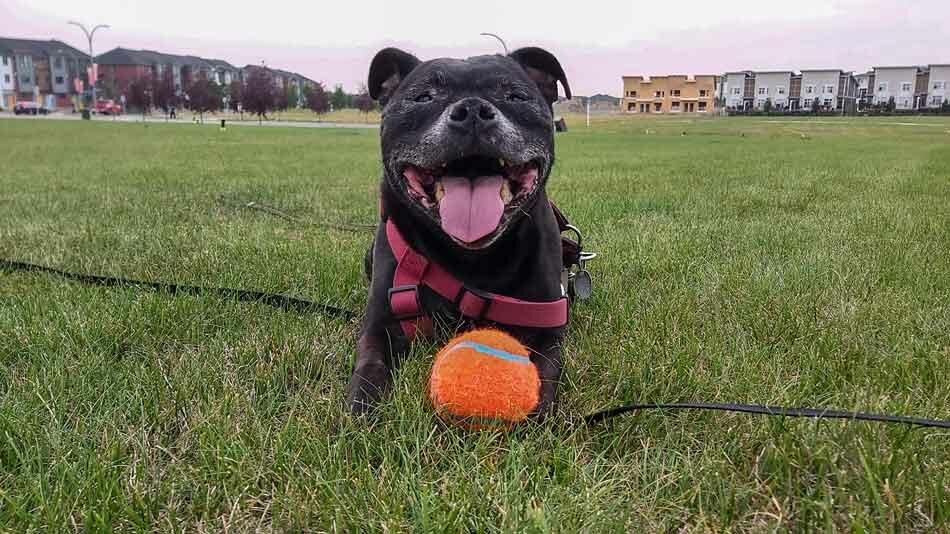
I know how daunting of a task it can seem to be for some Staffy owners. They can be very strong willed, and are always eager to be doing activities. You can harness this energy and teach your Staffy to walk on a loose leash.
With the tips mentioned above applied consistently, patiently, and calmly over time you will have a Staffy that doesn’t pull on leash. I have done this with my Staffy with great success. Granted I had many years as a professional dog walker behind me before getting my Staffy, but these same tips can be applied to any dog. Even ones that you only walk a few times a week and live with someone else.
I had many clients that would see me walking with their dogs and thought I was a magician. They couldn’t believe how well behaved their own dogs could be on leash with me.
This wasn’t any magical power, or special treat I had hidden away. The trick was consistent application of my leadership, and communicating to the dog how I wanted them to walk on leash.
Practice all of these tips with your Staffy and watch how a seemingly impossible task can become a beautiful transformation. With time walking with your Staffy will be an amazing experience of no pulling on leash, loyal focus, and true companionship.
PIBBLES & BITS TOP PICKS
King Komb DeShedding Tool – One of the best dog brushes on the market. I use the King Komb each and every week with my Pibbles. Easy to use and even easier to clean.
Wahl Dry Skin Oatmeal Shampoo – Smells great, cleans great, and best of all keeps my dog’s skin and coat looking and feeling amazing. Wahl Dry Skin Oatmeal Shampoo keeps my Pibbles skin moisturized like no other.
Earth Rated Dog Wipes – Dog wipes are an essential to keep on hand, and nothing beats Earth Rated. Hypoallergenic, biodegradable, and durable. I keep these dog wipes in the house and the car for everyday use.
Kong Extreme – Kongs are one of my most used tools to give my dogs some mental stimulation and something tough to chew. Kong Extremes are as tough as they come and will give your Pibble the entertainment they crave.
Outward Hound Food Puzzle – Outward Hound food puzzles are the best in the industry. Available from beginner to advanced. These are an excellent way to challenge and mentally stimulate your dog.
BeneBone Dog Chew – The toughest dog chew around. My dogs absolutely love the bacon flavor and peanut butter flavor BeneBone. These will keep your toughest chewers busy for weeks, if not months and years.
BarkBox Super Chewer – Variety is the spice of life, and BarkBox Super Chewer is the perfect way to keep your dog engaged. New treats, toys, and chews each and every month that your super chewer will love.
iCrate Dog Crate – The iCrate is my absolute top recommendation for dog crates. I use this for both my dogs and love the sturdy, easy to store, and versatile adjustable panel. You need the iCrate in your life.
HiKiss Long Training Lead – Recall training and puppy training outdoors requires a long training lead. My favorite to use is the HiKiss long training lead. Available in a range of lengths to suit your long lead training needs.
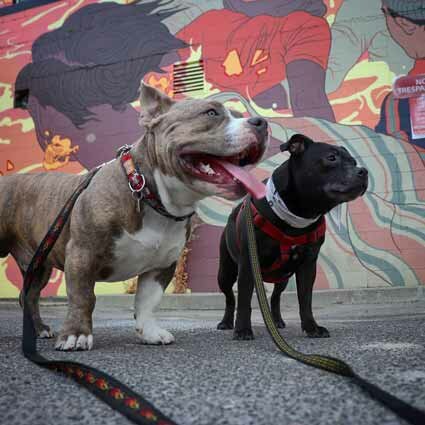
Join the adventures of Ruby The Staffy & Chester The Pocket American Bully!
Subscribe to our YouTube Channel!
